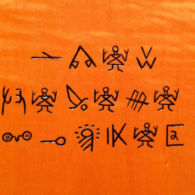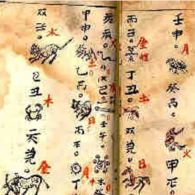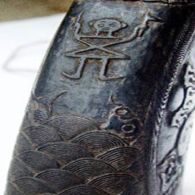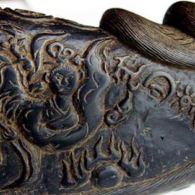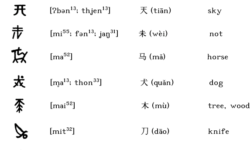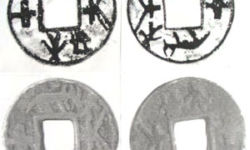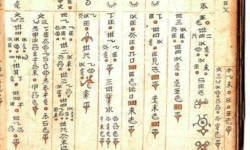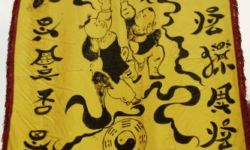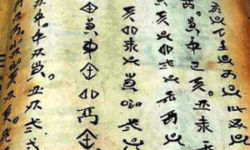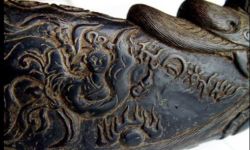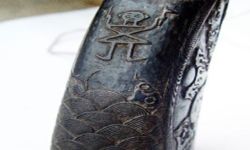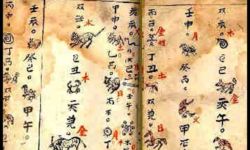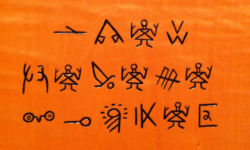Profile
The writing system for the Sui language, called Shuishu, is one of only two pictograms still in existence (the other being Dongba).According to tradition, the Shuishu characters, which are undoubtedly very old, were created by Lù Duógōng, who seems to be more of a mythical figure than an actual historical personage.
One legend holds that an ancestor named Lu Yigong spent six years creating the Sui script, at which point the Emperor send orders to burn his house, so from then on he memorized the characters so they could not be destroyed. Another legend says the script was created by six immortals including Lu Yigong who recorded the script using bamboo and cloth. When one of them was murdered, Lu Yigong decided to keep the script secret by reversing some of the characters and deliberately distorting others, thereby creating a coded script that has been passed down to the present day.
There are at least 500 different Sui characters in the Sui language — probably far more, as there are as many as 30 different variants for a single word. The script may also hold the world record for most consonants — no fewer than 70.
The script, like some other ancient scripts, was originally used for divination and other ceremonial purposes that nowadays would be dismissed as sorcery or magic. These practices were passed down orally or recorded in scrolls or books called “water books.”
The word “sui” means “water,” and the Sui refer to their language as “the water language” and themselves as “the water people.” The word for the Sui people collectively translates, fascinatingly, as “the aquarium.” The aquarium numbers some 400,000 people in China and Vietnam.
According to the Chinese intangible cultural heritage website, “The ancient script of the aquarium is called the water book. The water book is a unique text summed up by the industrious and intelligent aquarium ancestors in the long-term production and life practice. It is an ancient text symbol similar to Oracle and Jinwen. The water language refers to the water book as “泐睢”, which means ‘the words of the water house’ or ‘the book of the water house.’ The water book records the ancient astronomy, geography, folklore, ethics, philosophy, aesthetics, law, religion and other cultural information of the aquarium.”
Water books, of which some 6,000 exist, are collectively a combination of Bible, encyclopedia, history, law book, calendar, and book of spells — the Tao Te Ching of the Sui people. According to the South China News site, “In recent years, with its unique charm and high research value, Shuishu has attracted the attention of the world linguistics community, attracting more and more domestic and foreign experts and scholars to study water books… Experts believe that the ‘Water Book’ is equivalent to the Han Dynasty’s ‘Book of Changes.'”
The oldest were written in bamboo-tip ink, the more recent with a brush. They are not written with an explicit character-to-meaning correspondence, so they can only be read by someone knowledgeable in the subject — as was always the intention with the Sui script.
Other Sui texts include Ruyi divination cards, the Sui equivalent of Tarot, and a water-painted scroll apparently written during the Guangxu period of the Qing Dynasty. The book has 59 pages, with five kinds of colors, painted figures, buildings, cattle, horses, dragons, snakes, birds and beasts. The illustrations are realistic, vivid and familiar, reflecting the ancient aquarium’s pursuit of a better life and the pursuit of beautiful culture and art.
In 2006, Shuishu was included in China’s first archives of documentary heritage protection and the country’s first intangible cultural heritage protection list.
You can help support our research, education and advocacy work. Please consider making a donation today.
Links
General Script, Language, and Culture Resources
- Omniglot
- Wikipedia
- Bouyei-Miao Ethnic Autonomous Prefecture of Qiannan Article
- Shuishu Article (Chinese)
- Unicode Analysis of Shuishu Character Repertoire
- Scriptsource
- Shui Language Book (Chinese)

